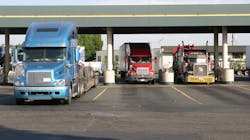The price of a gallon of diesel fuel is at the highest level since 1994, according to data from EIA. And while at one point in March prices dropped a bit, they are once again on the rise. Given world events it does not seem like we will see a significant drop in diesel fuel prices anytime soon.
Late last year we got an email from a logistics manager who shared his company’s journey to lower the carbon footprint of its supply chain. One idea that he described as low-hanging fruit was a handout for drivers that would remind them about what they can do to drive with fuel economy in mind.
At NACFE, we’ve long taken the view that drivers are a key element to improving freight efficiency. Of course, the way a vehicle is spec’d and how it is routed are important, but on a day-to-day basis the person sitting in the driver’s seat controls the way the vehicle operates, and that behavior can lead to big gains or losses in freight efficiency
See also: Act now to mitigate rising fuel prices
Given the price of fuel, now seems like the time to engage or re-engage drivers in your efforts to save fuel.
Here are some tips you can share with drivers. I’m guessing many of them already know these things, but sometimes a reminder doesn't hurt.
Watch speed and drive at a constant speed: We all know that driving fast increases fuel consumption. Every mile per hour driver over 60 mph reduces fuel economy by one-tenth of a mile per gallon. When possible, settle in on a speed and stick with it. Continually slowing down and speeding up is inefficient.
Find the engine’s sweet spot: Run the engine at the most efficient rpm.
Use cruise control: Cruise control allows the driver to maintain a constant speed and avoid unnecessary stops and starts.
Avoid hard braking and fast acceleration: Every time the driver touches the brake pedal, energy is lost. On the other hand, fast and hard accelerations also waste fuel not to mention being hard on the engine. Drivers should watch their intervals and keep the right amount of distance between them and the vehicle in front of them.
Tire inflation matters: Underinflated tires decrease fuel efficiency. Remind driver to check tire pressure often. Consider installing tire pressure monitoring/inflation devices.
Check condition of aero devices: Dents, rips, and tears in aero devices decrease their effectiveness. When aero devices get damaged, make sure to get them repaired at the earliest opportunity.
Minimize idling: At $3 a gallon and 100,000 miles a year, a 10% annual reduction in idling equals a $300 to $500 annual savings. Given today’s fuel prices that savings will be even higher.
See also: Finding the efficiency sweet spot in trucking
For 11 years—regardless of the price of diesel—NACFE has encouraged fleets to engage drivers in their fuel economy improvement efforts. Many fleets and drivers are on the fuel efficiency bandwagon. For the rest of you, $5 a gallon diesel seems like a pretty good reason to jump on. You’ll be welcomed.
Michael Roeth has worked in the commercial vehicle industry for nearly 30 years, most recently as executive director of the North American Council for Freight Efficiency. He serves on the second National Academy of Sciences Committee on Technologies and Approaches for Reducing the Fuel Consumption of Medium and Heavy-Duty Vehicles and has held various positions in engineering, quality, sales, and plant management with Navistar and Behr/Cummins.
About the Author

Michael Roeth
Executive Director
Michael Roeth is the executive director of the North American Council for Freight Efficiency. He serves on the second National Academy of Sciences Committee on Technologies and Approaches for Reducing the Fuel Consumption of Medium and Heavy-Duty Vehicles and has held various positions with Navistar and Behr/Cummins.
